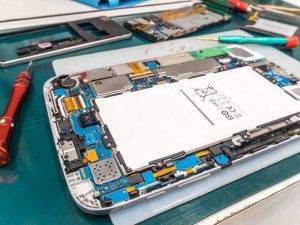 On average, popular phones, tablets and laptops are relatively easy to fix, but the market may be trending toward less repairable designs, a recent analysis found.
On average, popular phones, tablets and laptops are relatively easy to fix, but the market may be trending toward less repairable designs, a recent analysis found.
International activist group Greenpeace and U.S.-based electronics repair organization iFixit teamed up to assess the repairability of 44 smartphones, tablets and laptops. The devices, from 17 different manufacturers, included best-selling models in 2015, 2016 and so far in 2017.
“In general, the assessment shows enormous potential for improving the repairability of electronic products and for giving users the option to easily and affordably get their devices repaired to extend their lifespans,” according to the “How Repairable is Your Mobile Device” report from Greenpeace.
In addition to enabling repair, Greenpeace noted that ease of disassembly aids in parts harvesting and end-of-life recycling.
According to iFixit, this year’s exercise was the first time Greenpeace has incorporated repairability as a primary component of the scoring system for its consumer guide to greener electronics. The 1-10 repairability ratings (with 10 being easiest to repair) took into account ease of disassembly and the availability of replacement parts and repair information. The scores were published on a separate Greenpeace campaign website, rethink-it.org.
For the study, Greenpeace purchased 26 devices in China, Germany and the U.S. representing 17 manufacturers. The remaining 18 devices were obtained by iFixit.
Groups’ takeaways
In its summary, published in a blog post, iFixit said the devices, on average, scored relatively high in repairability.
“But Greenpeace’s results also show that many newer devices have lower scores than their predecessors, indicating that the market is trending towards less repairable designs,” iFixit’s Sam Lionheart wrote.
She also noted that laptops, in general, tended to be more repairable than phones and tablets, with the exceptions of Apple and Microsoft computers. Additionally, technicians were able to point to difficult-to-replace batteries, often secured with heavy adhesives, as a common cause of early device death. The group also found that few electronics manufacturers provide information and spare parts that would enable repair.
In its blog post reporting on the results, Greenpeace wrote that soldering of components to the board is making memory and hard drive replacements and upgrades more difficult than in the past. The group also said newer-generation phones are built with larger glass fronts, making them more prone to breaking.
Both iFixit and Greenpeace said the high-scoring examples – Greenpeace pointed to Fairphone, Dell and HP as positive role models – prove it’s possible for the others to improve repairability.
“The old ‘can’t-be-done’ argument isn’t a good one – there are devices that manage to be slim and repairable from other manufacturers in each category,” Lionheart wrote. “It can be done, and has been done.”
More stories about refurbishment/reuse
- AER expands to Pacific Northwest
- Oregon sends broad right-to-repair bill to governor
- Texas gets another uBreakiFix


